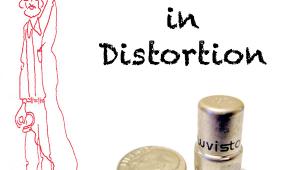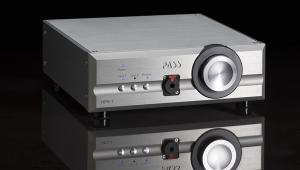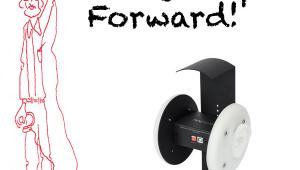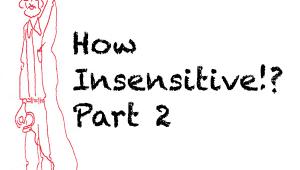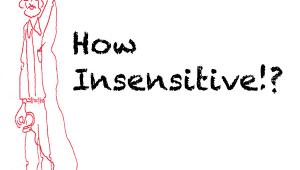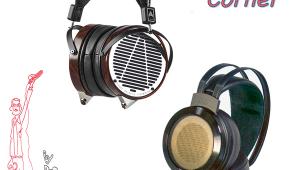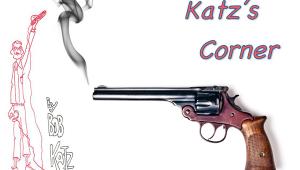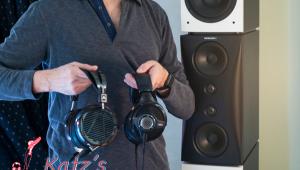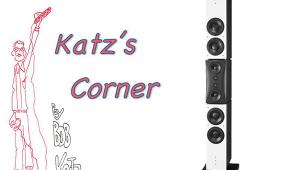| Columns Retired Columns & Blogs |
Katz's Corner Episode 11: The Oppo Explosion
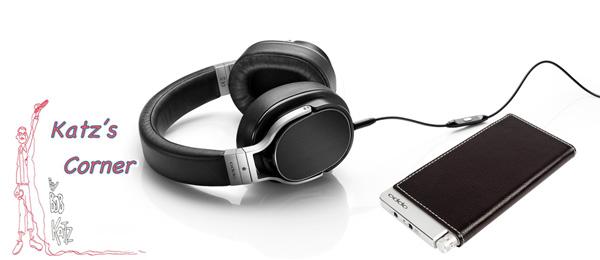
This story originally appeared at InnerFidelity.com
This is the most comprehensive equipment review I've published in Innerfidelity, as the quality of the gear under test and its astounding price/performance ratio warrant our full attention.
The Oppo HA-2 is a compact DAC/headphone amp about the size of an iPhone 6, a little heavier, but that includes a high-current rechargeable battery which can be used as auxiliary power for your cell phone. It's finished in brushed aluminum covered with a smart stitched genuine leather cover which evokes the look of a classic carry-round diary. Its features are well-considered: It has two flavors of USB jacks, and comes with accessory cables needed to interface with iPhone, Android, or desktop computer. Though intended for portable use, it can also be a DAC interface for your computer or recording engineers can bring it on location to use as a reference headphone amplifier from an analog source (via a 1/8" TRS jack).
The Oppo PM-3 headphones (which I reviewed en passant in Episode 10) come with two premium, flexible headphone cables, a one-meter with a remote control for portable use, and a three-meter for desktop use. (Source: PM-3, personal purchase. HA-2 amp, reviewer's loan.) I tested the HA-2 both in portable use with an iPhone 6 and desktop use with JRiver Media player. Retail price: HA-2 amp, $299; PM-3 phones, $399. So for about $700 plus the cost of a cell phone you can have high resolution 192 kHz/24-bit or DSD portable playback.
Ergonomics
The more I discover about Oppo, the more I admire the company, its forward thinking, and attention to detail. I already own an Oppo Blu-Ray player, which is solidly built and great sounding. The build of the PM-3 phones is clean and first rate. The controls on the HA-2 amplifier are easy to use and if you can read fine-print, each button, switch and connector is carefully marked so you do not need to refer to the instruction manual after you have read it once. Even if you cannot read the fine print, the switches are quick to learn just by feel.
The included 4 inch lightning to USB cable is designed to pair an iPhone with the DAC. Oppo thoughtfully includes two rubber bands to physically tie the two together, however, they block part of the LCD screen, so I keep them separate and replaced the cable with a longer Apple version. I use a belt pouch to carry both, or a pair of Banana Republic cargo pants! Even together, the two units are less bulky than a single Pono, which does not fit in your pocket (sorry, Neil)! The Astell and Kearn player is stylish and compact, but it doesn't answer phone calls, give you driving directions or flight times. So I like this two-box solution, and for jogging or non-critical listening, you can leave the DAC home and plug your cans into the iPhone. Clearly it would be better if the iPhone itself had a superior DAC and headphone driver, but this two-box solution is worth the trouble for the great improvement in sound quality.
I found when the iPhone went to sleep and then reawakened, sometimes the connection to the DAC was lost and the sound reverted to the iPhone's speakers. You can wake up the connection either by power-cycling the DAC or momentarily disconnecting the USB cable. Other than that small glitch, everything worked flawlessly and never crashed: Thanks Apple, thanks, Oppo!
Audio Connections
The fixed level line output, on 1/8" TRS, is designed to feed an external amplifier. The headphone output, also on 1/8" TRS, is controllable by the rotary analog volume control.
Resolution Galore
To play high resolution files (including DSD files and FLAC at high sample rates) from your iPhone, you need a special app. Oppo recommends the Onkyo HF player, which is full-featured, as rich as iTunes and includes a 64-bit high resolution equalizer. Thanks, Onkyo! I found it as easy to use as iTunes and just as pleasurable if not more. The file list is conveniently divided between high-res tracks and the iTunes database to make it easy to find the high res files. Being an Onkyo product, there are EQ presets for different Onkyo headphones. To use the Oppo phones, set the phones type to "other". However, I found Onkyo introduces an interesting subtle widening effect with the setting for the Onkyo H500M phones. You might like to try that. But the Onkyo phone presets cannot be used in conjunction with the equalizer. Engaging the EQ bypasses any headphone preset.
According to Oppo and Onkyo, the data exchanged between the app and the Oppo DAC is 32-bit fixed point. We already know that the ESS Sabre chip can use 32-bit data, so for all practical purposes, all of the resolution of the source music file is retained, even after digital equalization. Here's a bit of math explaining how I arrive at that conclusion: Truncation distortion in 24-bit calculations (if the calculation is not dithered) is potentially audible as it produces unmasked distortion products higher than the lowest level which the ear can hear (approximately -120 dB). However, 32-bit integer can encode 192 dB of dynamic range, so the distortion due to truncation would be so far below perception to be completely inaudible, assuming that the DAC chip itself does not truncate the 32-bit data, or that the remaining errors are far enough below the DAC's noise floor to be inaudible. The ESS chip's dynamic range is spec'ed at a remarkably high 127 dB, and its noise is lower than 21-bit noise. The Onkyo high-res equalizer is 64-bit (double precision), in order to handle the complex calculations without generating significant errors. This is then handed off to the DAC at 32 bits, which is a truncation and does cause distortion or errors of some magnitude. There are other errors along the way, but let's consider: even if cumulative errors might be as high as 40 dB above the LSB (a conservative, extremely high estimate), then the error might be as high as -152 dBFS, which is still completely inaudible, and also immeasurable at the analog output. Even if errors approach 50 dB above the LSB they would still be inaudible! Conclusion: Single precision 32-bit is a powerful format; the double-precision equalizer is icing on the cake. What's left is to determine how much analog resolution is lost due to noise when attenuating in front of the DAC chip, and whether the DAC chip audibly truncates any of the data. I'm betting that it is unnecessary to dither the signal going to the DAC. What remains to be proved is how well that all works, which can only be confirmed through measurements and listening tests.
All About That Bass
My experience with the sound of the highest model Astell and Kearn portable player introduced me to the warm quality of the ESS Sabre DAC chip, but it did not prepare me for the thrill of this portable system: the incredibly microdynamic HA-2 with the well-tuned PM-3 headphones, driven digitally by the iPhone. Every dynamic cut I own plays with amazing impact! I found drums and percussion to be clean, punchy, and snappy (when the recording itself had snap to deliver). The battery-driven HA-2 never seems to run out of steam so clearly Oppo have engineered a regulated, tight power supply.
On the PM-3's, well-recorded acoustic upright bass sounds full, deep, and punchy with perfectly even notes (but read on). With my desktop AMB M3 amp and the Slim Devices DAC, I felt that a half dB drop circa 60 Hz would perceptually flatten the bass response, but on the HA-2/PM-3 combination, flat sounds correct to my ears down to about 60. Perhaps this is because the M3 amp is DC coupled and/or the HA-2 has a slight rolloff. I'll look for this issue when I measure. The bass response seems to go down to the center of the earth; deeper and cleaner than any moving coil headphone in my experience, and rivaling my equalized Audeze LCD-X and Stax cans driven by the world's best desktop amps. In general, not a single note stands out too far to expose a resonance, but there's a little devil is in these details.
Judging bass response in headphones is an imprecise science. According to Harman research, listeners prefer some kind of bass boost. I prefer less boost than typical consumers, because I listen a bit louder, which would bring the perceived bass up due to the equal loudness contours. So, for me, flat to 60 Hz sounds just right on these phones with the HA-2. After study of many cuts I know well, I concluded that there is a subtle rise in the PM-3's low frequency response below about 60 Hz. This includes the notes A, G, F, E, and D (36.7 Hz). The latter is used on occasion by the 4-string electric bass in hard rock with "Drop D" tuning or the five string in fusion jazz. So the residual resonance of the PM-3 lives below 60 Hz. Well, if there has to be an anomaly, let's put it below most of the musically significant bass notes! The reason we don't initially notice a resonance with these cans is that there is rarely a bass note to excite it, and when there is one, our ear's natural insensitivity in this region makes it sound very musical. Good choice, Oppo: These are very linear headphones!
To complicate the matter, a lot of what we hear with bass notes are the harmonics, and a lot of recordings which seem to have good fundamental are fooling us, as for a low B (61.7 Hz), they are actually taking advantage of the second and third harmonic (123 and 185 Hz), the frequencies which help give the note its definition. Typical open-headed kick drums' primary frequency is 60 Hz. Below 60 Hz is the frequency range occupied by the bottom end of the thumps of the bass drum. Below 60 is where the upright bass instrument's "rumble" and "solidity" live; it's the part of the acoustic bass that is felt as much as heard, however, typical stereo systems are weak in or incapable of reproducing this range. Obviously it's the least important range, but when a loudspeaker can reproduce it, it can enhance our sense of reality and enjoyment of sound reproduction. On headphones, subsonic is rarely a problem range, because most phones don't go down that far, but the advent of the planars has reawakened our interest in this range. I can tell that the PM-3's have that rare response down to the lowest octave, since I can hear a sonic difference when equalizing the 31.5 range.
It's difficult to subjectively judge how much subsonic information to permit when equalizing headphones. With loudspeakers, you feel subsonics in your chest and body as well as your ears. Headphones do not deliver that total sensation, plus they literally press the bass drum onto your eardrum. It's unnatural and fatiguing to hear too much subsonic information in a transducer a few inches from your ear drums, although it can be terrific on loudspeakers like mine which are flat (0 dB) to 20 Hz, minus 3 dB at 17 and then the response drops off a cliff.
In the days of LPs, you almost never heard fundamental bass below 70 Hz because it ate up the groove spacing and reduced the playing time of a side. Most popular music recordings are still rolled off in this range, as engineers often remove mud from the bass drum and bass, but my recording of Joachim Palden's band is an intentional exception. This recording is particularly problematic on the PM-3's because it has distinct and intentional subsonics to below 20 Hz. We wanted the power and rumble of the bass and bass drum to extend to their deepest potential, but this is problematic when reproduced that close to the eardrum. The EQ which I arrived at for perceptual flatness with most recordings is flat at 1 k, down -0.1 at 63, -0.8 at 46 and -1.5 at 31.5. But this EQ is simply too heavy below 60 for the Palden recording, producing ear fatigue. So I created a second EQ for programs with extra subsonics that's an additional 1/2 to 1 db down at the two lowest bands. This yields an analogous sensation to the loudspeakers without fatiguing pressure on the eardrums.
I advise caution when dealing with subsonics because the ears are very insensitive to pressure at extreme low frequencies! I'm reminded of my high resolution recording of a shuttle launch. March 8, 2001, I was invited to attend the launch of Space Shuttle Discovery at the press box, so I brought some very special recording gear to capture the launch without any distortion. This recording is available at no cost on my website, www.digido.com. The sound goes down to 8 Hz but this cannot be appreciated in the home unless you have one of those expensive fan-driver subwoofers with response down to DC, and then it would be purely felt and not heard. So 8 Hz response would be useless in phones, and probably would cause serious vibrations if they could reproduce this frequency. During the launch I felt the 8 Hz-centered noise, 127 dB SPL, multi-kilowatt wave deep in my chest without any ear pain whatsoever. It was an amazing experience that I can never repeat since after 9/11/2001 us civilians are not permitted within the 3 mile limit during a launch. Only government officials, congressmen and dignitaries can enjoy a launch from the press box after 9/11. Especially since the shuttle program is no more and the only rockets coming out of Canaveral are military satellite launches.
I'll tell you more about fine-tuning the EQ after our listening report.
Listening Report: Portable Use, IPhone with Onkyo HF Player, Oppo HA-2 Amp and PM-3 Headphones
During the making of this review I've had to "recalibrate" my ears more than once! Some products which I formerly have given an A grade have been reduced to B. New products of higher quality than I have previously heard have replaced them, so let's see what has developed.
We'll start by listening to some notable musical examples, auditioned portably all over my house because they sound so infectious I couldn't put the phones down! Later I will try substituting the HA-2 for the Slim Devices DAC in the desktop system feeding my M3 amp, try to see how much of the magic is in the amp and how much in the DAC. These recordings were auditioned some with a flat EQ and some with the custom EQ, but really the custom EQ is an icing on the cake, it's not necessary to appreciate the virtues of the PM-3 phones.
From HD Tracks: Arthur Fiedler and the Boston Pops, Hi-Fi Fiedler, at 88.2 kHz (upsampled in the Onkyo player to 176.4). My dad had this LP and passed on the love to his son. The glorious Hungarian Rhapsody...when the orchestra hit its sforzando I nearly jumped! An experimental early stereo LP, made from 1957-1960 to 30 IPS 3-track tape, this recording has stood the test of time. It is bright and saturated on the peaks, but there's so much romance, bloom, depth, richness, beauty, and expression that I quickly forgive it. Some of the cuts are quite fuzzy on the peaks, but others are glorious with just a bit of tape saturation, regardless of which, this is one of my top reference pleasure orchestral recordings.
From HD Tracks: Cat Stevens' Tea for the Tillerman. Lovingly restored from the 15 ips 1/4" analog to 2496. But I never would have guessed it was "only" a 15 ips because of its fabulous macro- and microdynamics which come through so well on this portable playback system. This classic 1970 release sounds as clear as if it had been made yesterday, pure, and amazingly dynamic. They don't make 'em like they used to. Cat's voice sounds just like it does from the reference loudspeakers, with a lot of presence but never unpleasant. Wikipedia calls Cat Stevens one of the most important musical performers of the 20th century. Whether or not you were around when the recording came out, you'll love this 2496 file from HD tracks; it took me right back to my youth and the carefree feeling that Stevens portrays throughout the album. The residual tape distortion is very tolerable.
Joachim Palden Trio: Guilty, 2496 BK master. I highly recommend this CD for traditional blues lovers. This is one of my best-sounding blues recordings. Joachim is a master on the keyboards. On the portable system it sounds exactly as Joachim and I intended: fat, impacting, big, punchy, just right with the headphone EQ designed for extra subsonic rolloff (described later in this review). The bass from the organ and bass instrument is purposely larger than life, perfect for electric blues. The HA-2 with the PM-3 phones produces a palpable sound, so impacting you can practically touch it. I'm sure a lot of that has to do with the deep, punchy feel of the bass. Dana Gillespie's sexy contralto voice is a real turn on. I passed the phones to Mary to enjoy Flip Flop and Fly and she sat mesmerized through the whole cut. Despite not being an audiophile, she immediately remarked on the focus of the center image and the palpability of the sound. I hope someday to see the 2496 version released for sale as it sounds even warmer, deeper and purer than the 1644 reduction.
You may be familiar with the Buena Vista Social Club, a very pure acoustic performance available in high resolution on HD Tracks. The classic traditional Afro-Cuban performance with soaring vocal harmonies puts chills up my latin-loving latissimus*. This recording is warm, beautiful, and spacious with a deep bass resonance that may require the extra "anti-subsonic" EQ for the PM-3s.
*That's the broad muscle in your spinal area!
From HD Tracks: 2496, 52nd Street, headlined by bass player Andy Gonzalez. The upright bass is holographically real on the Oppo phones. The instruments sound so alive you can touch them. Great stereo image and depth. This is another one of my references, highly recommended if you like Latin Jazz played by a small acoustic ensemble.
The center image from these phones is perfectly focused, so the left and right channels, right down to the Oppo transducers themselves, must be very well matched. Raising or lowering the little analog volume control on the top of the HA-2 does not seem to shift the image, which is a remarkable achievement considering how difficult it is to manufacture a matched volume control in this size. I still can't believe it's true since I've never before encountered a consumer-grade analog volume control that matches left-right gains this well, down to the lowest level. This is further evidence of Oppo's attention to detail. Could this be a DC-level controlling an analog gain cell? I wouldn't be surprised.
Fine Tuning the EQ
According to Onkyo, this equalizer is a linear-phase, FIR EQ. As a mastering engineer, I've found a linear phase high frequency boost for program EQ sounds greatly superior to minimum phase. Linear phase EQ preserves the depth image, while minimum phase EQ brings the image forward when the high frequencies are boosted. There is no distortion or image warping with linear phase. However, linear phase may not be is superior for transducer compensation. Transducer errors, which are typically minimum phase, should be corrected with a minimum phase EQ, which produces the inverse of the transducer error. In fact, I've found when the program is already perfect but the transducer needs some high frequency help, a minimum phase high frequency boost sounds a little better. So in a perfect world, Onkyo should give the user a choice of which characteristic to use. Regardless, the Onkyo EQ is very sweet and capable of the most subtle corrections and I would not kick it out of bed! Keep in mind that the EQ operates in the PCM domain and is bypassed when playing DSD files.
The ergonomics of this equalizer are good but one function puzzles me. You can start with a flat response by loading a preset. Tapping your thumb on any point in the frequency graph produces a new dot which can be dragged up and down. But there is no way to erase a dot, so if you're not careful, the graph will quickly become littered with dots that you have to move to the 0 dB line if you don't want an active filter at those points. But I beat the system, and you can, too! I found a way to precisely set the EQ in 0.1 dB increments or less if you want and place dots precisely anywhere on the graph: Using an OSX App called iMazing allows me to exchange files between my iPhone and my Mac. I extracted an EQ document from the iPhone and found the EQ settings are written in XML, which can be directly edited with a text editor! For example:
[array]
[real]1000.0[/real]
[real]0.0[/real]
[/array]
[array]
[real]32000[/real]
[real]1.1478259563446045[/real]
[/array]
(Ed Note: "<" and ">" symbols have been replaced by "[" and "]" so they can be seen in an HTML web page.
This means that 1 kHz is set to flat and 32000 Hz is boosted 1.1 dB (expressed to 16 decimal places if you want!), producing a gentle rise in the high end. So you can edit this file to produce exactly the curve that you'd like. Thanks, Onkyo! Even if you're all thumbs on the iPhone touchscreen you can precisely edit this file on the desktop Mac and send it back to the iPhone. Later when measuring I found the EQ circuit drops level 3 dB, so if you don't boost any frequency more than 3 dB, you won't have to worry about digital overload. Hints: You'll have to explicitly flatten each octave by adding more dots or it will draw a slight dip in the curve between 31.25 Hz and 1000, unless you're looking for a dip.
As I reported in Episode 10, on my desktop system (JRiver, Lynx interface, AES/EBU into Slim Devices DAC, M3 headphone amp), the Oppo PM-3 cans seem to need some high frequency boost. But I found the HA-2 DAC has much more audible definition and resolution than my desktop DAC: On the portable player I found the PM-3 hardly needs any high frequency boost. With well-recorded music, the HA-2/PM-3 combination sounds so open that you don't feel deprived when playing it flat. I finally decided on + 1.1 at 32 kHz, up from 0 dB at 1 kHz using a straight line tilt. If I turn up the high end even 0.1 dB more, it noticeably dips the fundamentals of vocals in the lower midrange, so this must be optimum tilt, the icing on a very nice-tasting cake. Hey, Tyll, you can write up about EQ since your readers will be interested in these player apps. So that's fair game for you to review. I look forward to Tyll getting an iPhone and a Mac soon (insert smiley face here). You may be able to extract these files on a PC as well, though I have not tried.
(Ed Note: I'll work on it, Bob. Got a few irons in the fire to flesh out my understanding of EQ on headphones, but it's something I'll definately do when I get my ducks in a row.)
Clearly Onkyo has put great attention to detail into this application and it has already received numerous user-driven revisions. I hope they will consider my suggestions: I'd like to find a way to let the user delete a dot. I'd like to see the position of a dot displayed with more precision by adding 1/2 dB step graph lines, and also display the overall gain in dB. I'd like to see the main digital volume control displayed in dB as well.
Upsampling
I didn't spend much time comparing upsampled to 1x rate. On a simple comparison, the difference was quite subtle but I think the upsampled version has a bit more depth. After that I just let the app do its upsampled thing.
Gain Staging The HA-2
Everything about this software and hardware has been optimized for high resolution sound. The digital volume control in the app directly controls the built-in 32-bit volume control in the ESS chip. Oppo recommends setting the digital volume control at full and then making final adjustments through the analog volume control. But the errors (distortions) from 32-bit fixed-point (integer) communication are so far below the noise of the DAC that it hardly matters whether you attenuate via the digital control or not. So feel free to use the digital volume control if it's more convenient than the analog.
Beats the iPhone's Amp
I did a quick switch between the built-in amp/dac in the iPhone and the HA-2. It's no contest: The HA-2 has much better resolution. On the iPhone's own amp, bass is soggy and wimpy, and the sound is just not as clear. But for jogging and casual playback I have no problem just taking the iPhone out with these incredible Oppo phones.
Listening Report: On the Desktop, HA-2 as a Line-level DAC
I'm no stranger to asynchronous USB as I have the excellent portable Centrance DAC-port/headphone amplifier, which is self-powered from USB. But it doesn't have a connection suitable for use with the iPhone and so it mostly sits idle unless I take my MacBook Pro on location. In the mastering studio I've not used USB. I depend on AES/EBU for a multichannel connection to 10 channels of DAC! But there is no reason why I cannot employ asynchronous USB for a headphone connection and so I was very curious to try the HA-2 as a desktop DAC for headphones, either feeding its headphone output, or into my custom-build AMB M3 headphone amp.
The first thing I discovered, moving the PM-3s into my quiet studio (NC-20 rated) was that I can feel the pulse in my temples when I put on the cans with nothing playing! It's easy to ignore, but quite disconcerting at first. That's how quiet my room is and how good are the seal and isolation on these comfortable little headphones.
The desktop amp I chose to compare with the HA-2 is my custom-built AMB M3, which I felt was the best-sounding standard headphone amplifier at Big Sound 2015, and the equal in resolution, punch, definition, and channel separation to Tyll's custom KGSS electrostatic amplifier. In the studio I compared five options:
1) JRiver ---> USB ---> HA-2 ---> Headphone output ---> PM-3 phones.
2) JRiver ---> USB ---> HA-2 Line output ---> AMB M3 amp ---> PM-3 phones
3) JRiver ---> USB ---> HA-2 Headphone output used as a line driver ---> AMB M3 amp ---> PM-3 phones
4) JRiver ---> Lynx AES-16 Card ---> AES/EBU ---> Slim Devices DAC ---> AMB M3 amp ---> PM-3 phones
5) iPhone HF Player ---> HA-2 ---> Headphone output used as line driver ---> AMB M3 amp ---> PM-3 phones
That's a lot to swallow so I concentrated on playing the same song each time. I used the song "Flip Flop and Fly" from the Joachim Palden album, which has bass and bass drum that go down into the subsonic range. The double-time boogie woogie piano is a perfect test for left hand definition, complemented by a breathy tenor, a big upright bass, and punchy drum set. The star is Dana Gillespie, a charismatic blues vocalist whose contralto voice has great body and presence. The overall sound of this recording is authentically "blues phat" but with plenty of presence and natural high end on the cymbals. This song is rhythmically infectious; sonically it has excellent low and high frequency extension, excellent separation, dynamic impact, power and purity of tone. It makes a great demo track and besides, I know this song cold, having mastered the track.
To cut to the chase, four out of five of these options sound nice; it's a matter of degree and polish, with the first place finisher getting a definite A+ and the third place a B grade. One option, however, got a C grade for sound. Let's find out which one.
First I listened to option 1, JRiver feeding the HA-2 amp directly driving the PM-3 phones. In this case, JRiver is outputting 32-bit fixed point through the USB. This seems a bit dark and a bit thick (or warm as some would say), not very extended at the high end. I felt the need for some high frequency boost EQ. Grade: A- (without EQ).
Then I tried option 2: I patched the line output of the HA-2 into the M3 amp, which fed the PM-3 headphones. Levels to the cans were matched as closely as I could using the stepped analog attenuator. With a 1 kHz test tone and a 20 ohm load, I was able to get the AMB to match the HA-2's headphone output within 0.6 dB. Upon listening, to be honest, I was underwhelmed with the sound of the HA-2's line output. It seemed wimpy in the bottom, a bit thin and uninvolving with less stereo separation. I conclude that the 15 k ohm load of the M3 amp might be a little heavy for the HA-2's line output. It might like to see something closer to an open circuit, perhaps 47k ohms or higher. Regardless, I did not like the sound quality of the line output. I took it out of the running and would give it a C grade if I had to use it. I was never able to prove that the issue is load impedance, but regardless, I suggest you exercise caution when considering the HA-2's line output.
Option 3: Fortunately, we have the option of using the HA-2's headphone output as a line driver. This proved to be a completely different sonic story! The HA-2's headphone output stage obviously has more active components than the line output, which could degrade the sound, but it has a much lower output impedance and can drive any load to well below 600 ohms. In my studio experience, line drivers that can feed real current into a low impedance load generally sound more robust and clearer than those which require a high impedance load. That was definitely the case with the HA-2 amp. With this connection I found the AMB amp to have considerably more presence, subjectively brighter than the HA-2 direct. In fact, I felt much less need to add any EQ: it sounds great flat. Does this mean that the AMB amp is bright-sounding or has a bit of edge to it? If it does, then it's euphonic distortion, a perfect match for these slightly dark PM-3 phones. It does not sound harsh or edgy or "transistory". At Big Sound 2015 Tyll and I did not find the AMB to be bright, just that it sounded distinctly open and clearer than the very darkest commercial competitors but attractive without any edge or harshness. At Big Sound the AMB was driven either by the Prism or the Antelope DAC, and both sounded similar. I have to spend much more time with the HA-2, the AMB and various DACs and phones to reach a definitive conclusion, but this is an A grade playback.
Option 4: AES/EBU to the Slim Devices Transporter DAC and into the AMB amp. This is (was) my standard headphone playback method until I got the HA-2. In this case, JRiver is dithered to 24 bits to accomodate the wordlength limit of AES/EBU. The verdict: No contest. This has been downgraded to grade B. Compared to the HA-2 DAC, the Slim Devices is less resolved, with less depth, smaller soundstage, veiled. It requires considerable HF boost to try to overcome its veil, but it can't improve the loss of resolution. Could this be the dreaded j*tter? The 24-bit interface versus the 32-bit interface? The outdated chip in the Slim Devices DAC? In any case I will have to abandon the Slim Devices DAC for critical headphone listening. We have a new winner and established a whole new standard.
Option 5: iPhone with HF Player ---> USB ---> HA-2 amp headphone output as a line driver ---> M3 amp ---> PM-3 phones. This sounds very similar to JRiver but superior! The HF player sounds a little warmer than the desktop JRiver, and perceptually goes down a bit deeper in the low end. In other words, the HF Player has a warmer and deeper output through USB through the same DAC. This is very puzzling. Theoretically both software players are sending the same digital information...or are they? Without EQ, the HF Player sounds darker than JRiver, but it is very pure, resolved, rhythmically impactive, and involving. In fact I feel the HF Player has better sub-bass impact. How can a portable playback system get a better grade than a desktop? But it does! This is definitely an A grade system or A+ with a little HF boost applied.
What's going on? Does this mean that the HF Player has less distortion than JRiver? Does the portable USB interface perform better than the desktop? Why would that be? Keep in mind that interface jitter is irrelevant with asynchronous USB, and regardless of the player, the internal clock of the HA-2 is always the master, so I can only chalk up these differences to the mysteries of the universe. I will try to get to the bottom of this puzzle with measurements, but cannot promise a definitive explanation. Please don't send me any jitterbugs or other magic USB cures, I'm not ready for voodoo yet.
Listening conclusions
How much of the magic is in the amp, and how much in the DAC? Answer: a little of both. The M3 amp seems to have the perfect definition and clarity for the PM-3 phones, but it may be because it's a little on the bright side or has a bit of euphonic distortion, to be determined. Comparing the HA-2 DAC to a classic AES/EBU DAC is no contest: USB rules! The slight sonic differences I found between software players are a bit of a mystery and will require considerable further investigation.
Measurements and Objective Tests
Frequency Response - I measured both JRiver and the HF Player using discrete sine wave tones, identical 24-bit dithered -20 dBFS FLAC files that I created. I was able to switch between software players in an instant by simply switching the USB input on the bottom of the HA-2. I normalized the HA-2's analog gain to produce an integer dBu value at 1 kHz for easy comparison. I was unable to match channels to better than 0.1 dB, so at 1 kHz, HF player produced -11.0/-11.1 dBu (left channel/right). Then when switching to JRiver, the identical test tone read -10.8/-10.9 dBu, so JRiver produces 0.2 dB higher level at 1 kHz than HF player, and this was consistent. What's going on? The player engines are measurably different!
What are the possible causes of these level differences? Firstly, I confirmed that both apps were set to full (0 dB) gain and not doing any EQ or other processing. However, Onkyo is upsampling the 96 kHz signal to 192 kHz, but it produces identical output at 1 kHz with or without upsampling. Anyway, I was curious to see the high frequency response with the upsampler engaged. JRiver has an upsampling filter available but my past distortion measurements show that it does not like non-integer ratios, so I have not used its upsampler. Another possible cause of the level differences is that JRiver's native engine is 64-bit float, and it therefore truncates to 32-bit fixed. I doubted one could measure this effect on an analog output, but I did find some distortion differences between the two players (see below). In contrast, the HF Player is native 32-bit fixed with a 64-bit fixed equalizer. So this difference could be rounding or truncation error within JRiver, or some other factor that I cannot determine. For frequency response, I determined all levels relative to each player's response at 1 kHz, which by definition is 0 dB.
Both player's frequency responses match within 0.1 dB or less at all frequencies up to 20 kHz when normalized to 1 kHz. 20 kHz measures -0.1/0 in HF Player and -0.1/+0.1 in JRiver, which could easily be due to a digit rounding error in my Fluke 199C, so I discount any differences unless they are greater than 0.1 dB. All frequencies in the mid band of both players are flat within 0.1 dB or less, with losses only at the extremes. 20 Hz response is effectively flat, measuring -0.1/-0.2 dB in both players. 10 Hz is only 1 dB down! This is an exemplary, very rare bass response for a portable player, indicating either the use of very large capacitors or DC servo circuits.
The "smoking gun" (if there is one) is the difference in 30 kHz response (the highest frequency I measured). At 30 kHz, the HF Player measures -0.5/-0.3 and JRiver measures -0.1/+0.1, an 0.4 dB difference. So the HF Player begins dropping its HF response where JRiver remains flat. This probably reflects the characteristics of the upsampling filter in the HF player. I regret not having measured the 30 kHz response with upsampling turned off, or tried even higher frequencies, so this must remain a conjecture.
Onkyo's one-sheet for the HF Player tells us:
"When designing the HF Player's digital filter, our engineering team took the unique characteristics of your device's D/A converter and other associated hardware into consideration in order to achieve outstanding performance. Each filter coefficient is individually tuned according to sampling frequency for sound quality that surpasses theoretical signal-to-noise ratios, not only for Studio Master-quality Hi-Res Audio, but also for compressed audio files such as AAC and MP3. With HF Player, you can experience a clarity and vibrancy previously unobtainable on your mobile device."
Translation: This may be marketing talk. Or it could refer to the high resolution of its filtering engine, which keeps digital distortion and noise below the floor of any DAC. But at least there is a measurable frequency response difference. Although the HF Player produces slightly less output at 30 kHz than JRiver, it is clearly flat to 20 k. Is this the reason why the HF Player sounds a bit warmer and appears to go down lower than JRiver? I doubt it.
Distortion and Noise
I have not yet measured THD, but many authorities consider this to be a meaningless figure. Instead I looked at an FFT of the headphone output. Due to an attenuator in the circuit, I was not able to get a peak level higher than -10 dBFS into my Prism ADC, so the noise of the Prism ADC itself is a factor, but we can still see differences and conclude that the HA-2 is a very quiet amp indeed.
For example, Fig. 1 shows the noise floor of the HA-2 amp with no signal (green) vs. power off (blue). The measurement is only about 4 dB quieter with the amp turned off than on. Some of the residual noise is the instrument amp input of the Prism and the Prism's ADC itself, but in this measurement we can see that the HA-2 is nearly as quiet turned off as on!
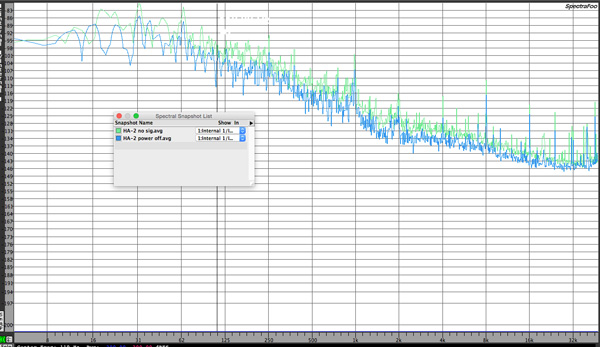 Fig. 1: HA-2 amp with no signal (green) vs. HA-2 amp powered off (blue).
Fig. 1: HA-2 amp with no signal (green) vs. HA-2 amp powered off (blue).
Next we look at distortion at 1 kHz, at 0 dBFs and at -10 dBFs, comparing JRiver to HF Player. I hesitate to show these graphs because they will be misinterpreted because the magnitudes of this distortion are so low in any case as to probably be inaudible. What makes the graphs interesting is to see visible evidence of different digital engines doing the calculation, so let's look at them for that purpose.
In Fig. 2 we compare each player's distortion at 0 dBFS, 1 kHz. JRiver is in orange, HF Player (iPhone) in turquoise. JRiver exhibits between 2 and 12 dB more high frequency distortion at some frequencies than HF Player, and has up to an 18 dB lower noise floor than HF player at low frequencies. I chalk up the noise difference to the noise of the upsampling/anti-image filter in the HF Player, which is obviously measurable, though certainly below audibility. I wager the distortion differences are due to JRiver's rounding of 64-bit floating point to 32-bit fixed, while HF Player is 32-bit fixed native. Let me repeat that these measured differences are for academicians, not for listeners. I strongly doubt they contribute to any sonic difference.
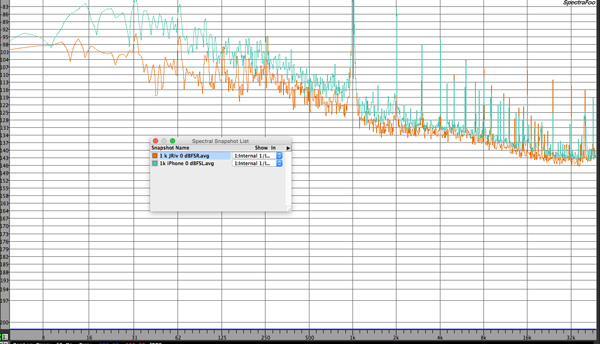 Fig. 2: HA-2 amp driven to 0 dBFS at 1 kHz. JRiver player (orange), HF Player (turquoize).
Fig. 2: HA-2 amp driven to 0 dBFS at 1 kHz. JRiver player (orange), HF Player (turquoize).
Figure 3 compares the players with a more sensible -10 dBFS 1 kHz signal. Here we can see that JRiver's distortion has greatly reduced and is much closer to that of HF Player. The noise floor differences have not changed.
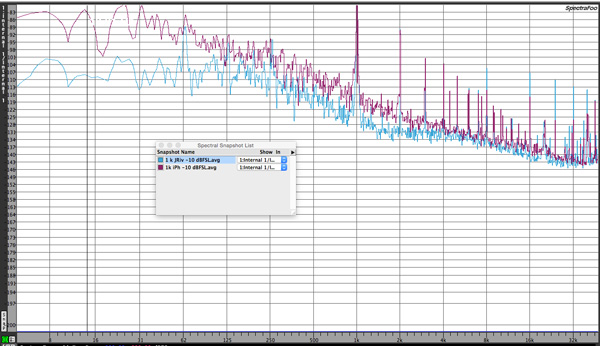 Fig. 3: HA-2 amp driven to -10 dBFS at 1 kHz. JRiver player (turquoize), HF Player (magenta).
Fig. 3: HA-2 amp driven to -10 dBFS at 1 kHz. JRiver player (turquoize), HF Player (magenta).
I wanted to see if JRiver was uncomfortable feeding a 32-bit fixed point signal, so I engaged its 24-bit TPDF dither, thereby limiting the signal to the HA-2 to 24 bits. In this case the distortion went up, not down, so I conclude that the ESS DAC chip loves to get low level information below the 24th bit.
Volume Control
Note that the HF Player is capable of controlling the ESS chip's volume control via commands over USB, so the signal can remain at high level, 32-bit fixed all the way from the HF player through the chip's circuitry up to just before the oversampling filter. The ESS Sabre chip's volume control is located just before the oversampling filter. The idea of having a volume control at this late point is to maintain digital resolution for as long as possible in the chain. However, JRiver must perform its digital attenuation at 64 bits floating point, and then convert that signal to 32-bit fixed on the way to the DAC. In theory, using JRiver's digital volume control is inferior to computing in fixed point and/or using the chip's own volume control. But in practice I think we are trying to count the number of angels on a pin head. The noise generated within a 32-bit data path is so far below that of the DAC that it does not deteriorate signal to noise ratio. And the DAC noise itself is so low it is inaudible, even at full gain of the HA-2's analog control. In fact, if implemented well, both 32-bit fixed point and 64-bit floating point have such low inherent noise and distortion that either volume control approach is probably audibly indistinguishable, with reasonable amounts of attenuation. All PC-based players are floating point, to my knowledge. The only fixed-point players are on mobile devices.
I think the chip's digital volume control shines in applications like the Raspberry Pi, which does not have enough calculation power to perform a good volume control, but it can easily send control commands to the chip for a "perfect" volume control experience. To equal the quality of any of these digital volume controls, an analog control would have to be extremely well designed and quiet. Ironically, the analog volume control in the HA-2 DAC seems to qualify, so take your choice or exercise your prejudices and adjust whichever one your heart desires.
Clipping points: I verified with measurements and listening to sine wave tones that it is impossible to clip the DAC chip. A 1 kHz, 0 dBFS 24-bit dithered test tone does not clip the DAC, provided that the equalizer in the HF Player is bypassed. However, I could hear the circuitry in the DAC just going into clipping when boosting the 1 kHz EQ band by more than 3 dB, clearly clipping with a 3.6 dB boost. This correlates well with my measurement showing that the EQ drops overall level by 3 dB. So if you want to boost any band more than 3 dB, turn down the EQ gain by dragging your thumb downward until the highest boost level at any frequency is below the 0 dB line, which puts all material safe from digital clipping by 3 dB. However, if the equalizer is clipping, dropping the digital volume control will not fix the problem, making it clear that the digital volume control comes after the digital output signal of the App, and in fact it controls the built-in 32-bit volume control in the DAC chip itself. The app sends control commands for digital volume over USB to the HA-2. The digital volume control can be touch-screen adjusted to 0.1 dB precision if you are careful, or incremented in precise 4 dB steps by pushing on the iPhone's up and down volume controls.
The HA-2 has what I would call a perfect analog gain structure, neither too little nor too much analog gain at the high gain setting. With a 0 dBFS 1 kHz test tone, the headphone output does not visibly clip on the oscilloscope, even at maximum gain, into a high-impedance load. However, when loaded by 20 ohms, the output drops about 0.6 dB and goes into clipping, which is easily rectified by turning down the analog (headphone) gain about a dB. But no sane practitioner (who isn't already deaf) would ever need to turn the analog gain up this far! I measured 2.18 volts across 20 ohms just before clipping, which is 238 mW. Given the stated 102 dB/mW sensitivity of the cans, turning the analog gain up to just below amp clipping would produce 125.8 dB SPL level with a full scale signal. Ouch! A more normal (but still loud) situation would be to turn the analog gain down by 20 dB, which with a more normal level -20 dBFS RMS signal would produce 85.8 dB SPL. Most of you will run the analog control 7 to 10 dB lower than that. However, at maximum analog gain before clipping, there is only enough voltage to drive a pair of insensitive high impedance phones like the Sennheiser HD 600 to about 77 dB SPL with a -20 dBFS signal. The open-back HD 600 should do fairly well in a quiet room with pop music and jazz, but may be a bit low for wide dynamic-range classical music played in a normal or noisy environment.
Output Impedance and Level
Headphone amp output level drops about 0.6 dB when the output is terminated by 20 ohms, which calculates to approximately 1.5 ohms at 1 kHz, quite low for a battery-powered device. Just for laughs, I tried a 20 ohm load on the HA-2's line output and the level dropped precipitously. I did not try to determine the line output impedance, but I did measure a voltage level at 0 dBFS, 1 kHz, of +1.82/+1.62 dBu with HF Player into a 10 k ohm test load (right channel measures 0.2 dB lower than the left). This translates to 0.93 v RMS, about 6 dB lower than the standard output of a CD player. Plugging into the headphone jack disables the line output.
Analog Volume Control Tracking
I suspected that the analog volume control might be a DC level controlling an active circuit because the interchannel tracking was so good. But I was wrong, measurements indicate enough interchannel errors to imply the tiny analog volume control in the HA-2 must be a superior dual-channel model with excellent tracking. At low amounts of attenuation, channel differences are within 0.1 dB. However, at 10 dB of attenuation, this increases to 1 dB but never gets worse than 1 dB at any further attenuation down to 20 dB where I stopped measuring. Given production variances, it's possible that each HA-2 analog control will perform differently, but hopefully no worse than a dB error.
Switching to low gain drops the level about 9 dB, and the volume control will travel nearer the top of its range where the channels will track better. Low gain is sufficient for most musical sources I encountered. Or you can always attenuate with the digital control if you want a perfectly centered image, with no concerns unless you are a digiphobe.
Audible DAC Resolution
The HA-2 analog gain structure is so well-designed that there is no audible hiss with these cans, even at full analog gain! The noise floor of the DAC with high gain measures only a few dB higher than the noise floor of my Prism converter's instrument level input, which I used to view noise and distortion with a Spectrafoo FFT analyzer, so we are close to the limits of the measurement gear itself.
The lowest level single frequency tone which I can hear in the phones with analog gain turned up just below the clipping point is a 1 kHz -120 dBFS dithered test tone, give or take a couple of dB. This is audible only in a quiet room, very faintly, but it establishes the low level resolution of the DAC. An FFT measurement confirmed that -120 dBFS is about the lowest visible tone before it disappears into the noise. I don't know which ESS chip is used in the HA-2, but ESS specs 122 to 127 dB dynamic range for their chips so this correlates well with my measurement.
What does this resolution mean in practical terms? It does not mean we can hear discrete signals down to -120 dBFS because this tone was only heard with the analog gain maxed out. In practice, we could be using 20 dB less analog gain, which means that in a quiet room we should still be able to hear, at normal analog gains, a -100 dBFS tone, which is a fantastic achievement. At normal analog gain, that tone would produce 6 dB SPL, only 6 dB above the nominal threshold of hearing! Only audible in the most quiet room. There is no recording on earth with that low a noise floor; most recordings exhibit noise floors 40 dB or more higher. So this DAC and amp can handle anything we want to put into it.
Bottom line
Oppo PM-3 headphones plus Oppo HA-2 DAC/amp plus iPhone is the best-sounding, most accurate, reference-quality portable playback that I have experienced in many years of this audio business. The bass response is most impressive. The portable experience rivals the best desktop headphone amplifiers and DACs and the HA-2 can be used as a desktop DAC rivaling the best line-powered beasts. We're living in exciting times!
- Log in or register to post comments
